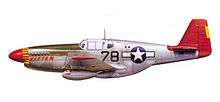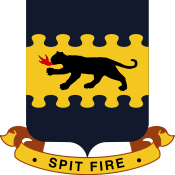Charles McGee (pilot)
| Charles E. McGee | |
|---|---|
 Portrait (USAF) | |
| Born |
December 7, 1919 Cleveland, Ohio |
| Allegiance |
|
| Service/branch |
|
| Rank | Colonel |
| Unit | 332nd Fighter Group |
| Battles/wars | World War II, Korean War, Vietnam War |
| Awards |
Legion of Merit with oak leaf cluster Distinguished Flying Cross with two oak leaf clusters Bronze Star Medal Air Medal with 25 oak leaf clusters French Légion d'honneur |
Charles E. McGee (born December 7, 1919) was one of the Tuskegee Airmen and a career officer in the United States Air Force for 30 years. He holds a US Air Force record of 409 fighter combat missions flown in World War II, Korea and Vietnam.
Early years
McGee was born in Cleveland, Ohio on December 7, 1919, to Lewis Allen and Ruth Elizabeth Lewis McGee who died shortly after the birth of his sister. His father was, at times, a teacher, social worker and Methodist minister, jobs that led to frequent moves.[1]
As a youth, McGee was a member of the Boy Scouts of America and earned the Eagle Scout award on August 9, 1940. He later served in district and regional positions in the BSA. At the 2010 National Scout Jamboree, he was recognized with the Distinguished Eagle Scout Award.[2]

World War II
In March 1942, McGee was a sophomore at the University of Illinois studying engineering. While at the University of Illinois he was a member of the National Society of Pershing Rifles. He also became a member of the Tau chapter of Alpha Phi Alpha fraternity. After enlisting in the US Army on October 26, 1942, he became a part of the Tuskegee Airmen having earned his pilot's wings, and graduating from Class 43-F on June 30, 1943.[3]
By February 1944, McGee was stationed in Italy with the 302nd Fighter Squadron of the 332d Fighter Group, flying his first mission on February 14.[3][4]McGee flew the Bell P-39Q Airacobra, Republic P-47D Thunderbolt and North American P-51 Mustang fighter aircraft, escorting Consolidated B-24 Liberator and Boeing B-17 Flying Fortress bombers over Germany, Austria and the Balkans. During missions, he also engaged in low level attacks over enemy airfields and rail yards.[5]
On August 23, 1944, McGee while escorting B-17s over Czechoslovakia, he engaged a formation of Luftwaffe fighters and downed a Focke Wulf Fw 190.[6]
Promoted to Captain, McGee had flown a total of 137 combat missions, and had returned to the United States on December 1, 1944, to become an instructor on the North American B-25 Mitchell bombers that another unit of the Tuskegee Airmen were working up. He remained at Tuskegee Army Air Field until 1946, when the base was closed.[3]

Postwar
After World War II, McGee was sent to Lockbourne Air Field (Columbus, Ohio) to become the base operation and training officer, later in 1948, being posted to an Aircraft Maintenance Technical Course and was assigned to an air refueling unit. When the Korean War broke out, he flew P-51 Mustangs again in the 67th Fighter Bomber Squadron, completing 100 missions, and being promoted to major. Continuing his service with the United States Air Force as it was reconstituted, McGee continued to serve as a fighter pilot, flying Lockheed F-80 Shooting Star and Northrop F-89 Scorpion aircraft.[7]
During the Vietnam war, as a Lt. Colonel, McGee flew 172 combat missions in a McDonnell RF-4 photo-reconnaissance aircraft. During his Southeast Asia combat tour, then-LT COL McGee served as the Squadron Commander of the 16th Tactical Reconnaissance Squadron (TRS), of the 460th Tactical Reconnaissance Wing, of which was based at Tan Son Nhut Air Base, in South Vietnam. The 16th TRS flew the RF-4C "photo-recce" Phantom II jet aircraft.
In a 30-year active service career, he achieved the highest three-war fighter mission total, 409 fighter combat missions, of any Air Force aviator.[6]
After a series of other appointments both in the United States as well as in Italy and Germany, and promotion to Colonel, McGee retired on January 31, 1973.[8] He ended his military career with 6,308 flying hours.[9]

Later years
After his military service, McGee held many prestigious functional and honorary positions around the field of aviation. In 1978, at the age of 58, he completed the college degree at Columbia College in Kansas City, over thirty years after his initial enrolment at the University of Illinois. Though interrupted by World War II, attaining a college degree had been a lifelong goal.[10]
McGee served as the Director of the Kansas City airport and as a member of the Aviation Advisory Commission. For over 30 years, he has been an ambassador of the Tuskegee Airmen, Inc., giving numerous public addresses and has received accolades including the National Aeronautical Associations "Elder Statesman of Aviation." McGee served as National President of the association from 1983 to 1985, and is currently serving as its president.[6]
In 2005, McGee intended to be part of a group of former Tuskegee Airmen, who flew to Balad, Iraq, to speak to active duty airmen serving in the 332nd Air Expeditionary Wing, the current incarnation of the 332nd Fighter Group.[11] Unfortunately, McGee was hospitalized prior to the trip and was unable to go.
Honors
McGee was recognized for his combat and military service with a number of awards including: Distinguished Flying Cross with two Oak Leaf Clusters, Legion of Merit with one Oak Leaf Cluster, Bronze Star, Air Medal with 25 Oak Leaf Clusters, Army Commendation Medal, Presidential Unit Citation, Korean Presidential Unit Citation, Hellenic Republic World War II Commemorative Medal along with related campaign and service ribbons. In 2007, President George W. Bush awarded McGee and all other surviving Tuskegee Airmen the Congressional Gold Medal, the nation's highest civilian award.[9]
In 2011, McGee was inducted into the National Aviation Hall of Fame in Dayton, Ohio. He also served as a consultant to the 2012 George Lucas film, Red Tails.[12]
References
Notes
- ↑ Smith and McGee 199. pp. 12–14.
- ↑ Maw, Michael. "Tuskeegee Airman Presented Distinguished Eagle Scout Award: 2010 National Scout Jamboree." Boy Scouts of America. Retrieved: January 23, 2011.
- 1 2 3 Francis and Caso 1997, p. 323.
- ↑ Sherman, Stephen. "The Tuskegee Airmen: First Group of African-American Fighter Pilots in WW2." acepilots.com, June 29, 2011. Retrieved: January 2, 2015.
- ↑ Tillman 2012, p. 28.
- 1 2 3 "Eagle Biography: Charles E. McGee." Air University (United States Air Force). Retrieved: February 5, 2012.
- ↑ Ray, Mark. "National Treasure: Decorated Col. Charles McGee Continues to Impact America's Youth." Eagle Scout Magazine, Winter 2010, pp. 5–7.
- ↑ Cooper et al. 1996, p. 116.
- 1 2 Francis and Caso 1997, p. 324.
- ↑ "Flying high: interview with Col. Charles McGee." Archived January 3, 2015, at the Wayback Machine. Columbia College Spotlight, July 2008. Retrieved: August 14, 2012.
- ↑ "Tuskegee Airmen suit up, head to Iraq." USA Today, October 22, 2005.
- ↑ "Columbia College alumnus Col. Charles McGee consults on George Lucas movie." Archived January 3, 2015, at the Wayback Machine. Columbia College Connections. Retrieved: August 14, 2012.
Bibliography
- Cooper, Charlie, Ann Cooper and Roy La Grone. Tuskegee's Heroes. St. Paul: Minnesota: Motorbooks International Publishing Company, 1996. ISBN 0-7603-0282-0.
- Francis, Charles E. and Adolph Caso. The Tuskegee Airmen: The Men Who Changed a Nation. Boston: Branden Books, 1997. ISBN 0-8283-2029-2.
- Smith, Charlene E. Mcgee and Charlene E. McGee. Tuskegee Airman: The Biography of Charles E. McGee, Air Force Fighter Combat Record Holder. Boston, Massachusetts: Branden Publishing, 1999. ISBN 978-0-8283-2186-0.
- Tillman, Barrett. "Tales of the Red Tails; Inside the Tuskegee Legend: The men, the machines, the missions." Flight Journal, February 2012.
